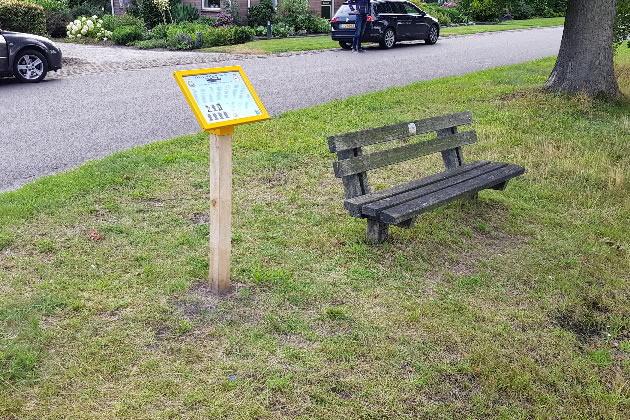Dutch Seek Details of Airman from Chiswick
Flight Sergeant Alexander Milton's plane was shot down in WWII

The information board at the crash site with missing details
May 28, 2023
A research foundation based in Holland is asking the people of Chiswick for help in finding out details of an airman whose plane crashed in its neighbourhood.
Stichting Luchtoorlog Onderzoek Drenthe seek to mark the site of each plane, allied or German, shot down during the Second World War with an information panel giving details of each individual crew member.
The Drenthe region borders Germany and the group’s main focus is its ‘Lost Wings’ project which has involved the installation of 39 these panels in both the Netherlands and Germany.
Flight Sergeant Alexander Henry Milton was the rear gunner of a Halifax DT630 VR-T that was downed by the Luftwaffe at Odoorneveen on 3 February , 1943.
The plane was part of 419 RCAF (Moose) Squadron which took off from RAF Middleton St. George Air Base at 6:34pm as part of an attack wave of 263 aircraft aiming for Hamburg.
Poor weather meant that many of the bombers turned back before reaching their target, but Flight Sergeant Milton’s plane had continued despite lagging behind the rest of the main body of the attack. In an attempt to catch up, pilot Jack D. MacKenzie pushed the nose down slightly to increase speed. He had the additional problem of the plane’s intercom system being out of action, so he had no way of contacting Flight Sergeant Milton.
At about 25 minutes short of Hamburg, they came under attack from a Messerschmitt Bf 110 nightfighter flown by Oberfeldwebel Karl-Heinz Scherfling. The Halifax performed an evasive manoeuvre called the corkscrew but was riddled with cannon fire which fatally wounded the pilot and Lennox AJ Gonnett, the dorsal turret gunner. The gunfire also ignited the incendiary bombs on board, burning through vital cables and pipes leading to the engines and controls. The flight engineer, William P. Duthie, attempted to extinguish the fire, but was unable to do so due to the flammable and difficult-to-extinguish nature of the incendiaries. The navigator, William N. Garnett, gave the order to abandon the aircraft using a previously agreed sequence of flashes of light to contact Flight Sergeant Milton due to the unavailability of the intercom system.
Eric R. Marquand, the bombardier, was the first of the crew to leave the aircraft. He was followed by William N. Garnett, who checked on the rest of the crew and saw that radio operator Raymond H. Hill was still in position, as was William P. Duthie who were both preparing to leave. At this point the German fighter turned back and attacked the falling Halifax once more.
Eric R. Marquand was hit in the ear while Flight Sergeant Milton continued to fire on the German fighter to drive it away so that the other crew members could get out. He continued to fire until he fell from his turret, but Duthie and Hill didn’t make it.
The three survivors were captured and sent to Stalag 344 Lamsdorf where they remained until 1945.

The site of the crash in February 1943
It is known that Flight Sergeant Milton was born in Hounslow in 1916 and after the war lived in Chiswick until his death in 2001. He served with RAF Bomber Command with the service number 1003107 but enquiries to various veterans’ organisations have yet to yield any further information about him. His mother was Elizabeth Susan Skinner (1882–1952) and his father was Alexander John Milton (1868–1959) and he was baptised on 25 June 1916, St Augustine, Highbury.
The Lost Wings project aims to have more detail as well as a photograph of the airmen shot down so if you have any further information about Flight Sergeant Milton, please send it to editor@chiswickw4.com.
Like Reading Articles Like This? Help Us Produce More This site remains committed to providing local community news and public interest journalism. Articles such as the one above are integral to what we do. We aim to feature as much as possible on local societies, charities based in the area, fundraising efforts by residents, community-based initiatives and even helping people find missing pets. We’ve always done that and won’t be changing, in fact we’d like to do more. However, the readership that these stories generates is often below that needed to cover the cost of producing them. Our financial resources are limited and the local media environment is intensely competitive so there is a constraint on what we can do. We are therefore asking our readers to consider offering financial support to these efforts. Any money given will help support community and public interest news and the expansion of our coverage in this area. A suggested monthly payment is £8 but we would be grateful for any amount for instance if you think this site offers the equivalent value of a subscription to a daily printed newspaper you may wish to consider £20 per month. If neither of these amounts is suitable for you then contact info@neighbournet.com and we can set up an alternative. All payments are made through a secure web site. One-off donations are also appreciated. Choose The Amount You Wish To Contribute. If you do support us in this way we’d be interested to hear what kind of articles you would like to see more of on the site – send your suggestions to the editor. For businesses we offer the chance to be a corporate sponsor of community content on the site. For £30 plus VAT per month you will be the designated sponsor of at least one article a month with your logo appearing if supplied. If there is a specific community group or initiative you’d like to support we can make sure your sponsorship is featured on related content for a one off payment of £50 plus VAT. All payments are made through a secure web site. |